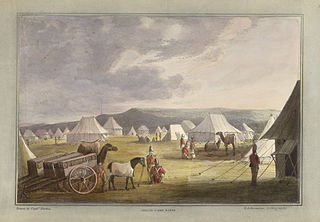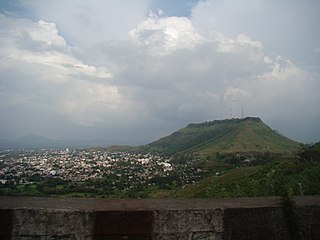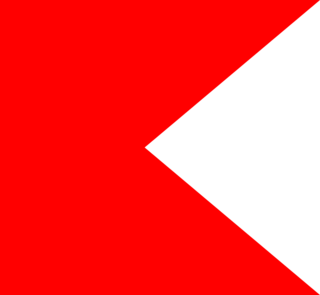
The Maratha Confederacy, also referred to as the Maratha Empire, was an early modern polity in the Indian subcontinent. It comprised the realms of the Peshwa and four major independent Maratha states often subordinate to the former. It was established in 1674 with the coronation of Shivaji as the Maratha Chhatrapati and recognised by Emperor Bahadur Shah I as a tributary state in 1707 following a prolonged rebellion. Following this, the Marathas continued to recognise the Mughal emperor as their nominal suzerain, similar to other contemporary Indian entities, though in practice, imperial politics at Delhi were largely influenced by the Marathas between 1737 and 1803.

The Third Anglo-Maratha War (1817–1819) was the final and decisive conflict between the British East India Company and the Maratha Confederacy in India. The war left the Company in control of most of India. It began with an invasion of Maratha territory by British East India Company troops, and although the British were outnumbered, the Maratha army was decimated. The troops were led by Governor General Hastings, supported by a force under General Thomas Hislop. Operations began against the Pindaris, a band of Muslim mercenaries and Marathas from central India.

The Peshwa was the second highest office in the Maratha Confederacy, next in rank and prestige only to that of the Chhatrapati. Initially serving as the appointed prime minister in the Maratha Kingdom, the office became hereditary after the death of Shahu in 1749. During the reign of Shahu, the office of Peshwa grew in power and the Peshwas came to be the de facto rulers of the Maratha Confederacy. However following the defeat of the Marathas in 1761, the office of the Peshwa became titular as well and from that point onwards served as the ceremonial head of the Confederacy underneath the Chhatrapati.

Satara is a city located in the Satara District of Maharashtra state of India, near the confluence of the river Krishna and its tributary, the Venna. The city was established in the 16th century and was the seat of the Chhatrapati of the Maratha Kingdom, Shahu I.

House of Scindia or earlier known as the Sendrak was a Hindu Maratha Royal House that ruled the erstwhile Gwalior State in central India. It had the Patil-ship of Kanherkhed in the district of Satara and was founded by Ranoji Scindia, who was sardar of maratha empire and real maratha warrior clan appointed by chattrapati shahuji maharaj-1's servant family from kokan worked as prime minister also known as Peshwa Bajirao I. Ranoji and his descendants, along with their rivals the Holkars, played a leading role during the Maratha ascendancy in northern India in the 18th-century. The Gwalior State became a princely state during the British Raj in the 19th and the 20th-centuries. After India's independence in 1947 and the abolition of princely states, several members of the Scindia Dynasty went on to enter Indian politics.

Shinde is a clan of the Maratha clan system variations of the name include Scindia and Sindhia, Sindia. It is found largely in Maharashtra (India), but it also appears in Indian states bordering Maharashtra like Madhya Pradesh, Gujarat, Karnataka, Goa, Telangana and Chhattisgarh.

Shahu I was the fifth Chhatrapati of the Maratha Confederacy founded by his grandfather, Shivaji I. He was born into the Bhonsle family, and was the son of Sambhaji I and Yesubai. At a young age, he was taken into custody at the Siege of Raigad by Mughal emperor Aurangzeb, and held captive. He was released from captivity after the death of Aurangzeb in the hope of engineering an internecine struggle among the Maratha factions of Tarabai and Shahu. Shahu emerged victorious in the bloody Battle of Khed and was crowned as Chhatrapati.

Maharani Tarabai Bhosale (née Mohite) was the regent of the Maratha Empire from 1700 until 1708. She was the queen of Rajaram I, and daughter-in-law of the kingdom's founder Shivaji I. She is acclaimed for her role in keeping alive the resistance against Mughal rule in Konkan, and acting as the regent of the Maratha Empire during the minority of her son, Shivaji II. She defeated Mughal forces of Aurangzeb in several battles and expanded the Maratha Empire.

Balwant Moreshwar Purandare, popularly known as Babasaheb Purandare, was an Indian writer of books and plays from Maharashtra, India. His works are mostly based on the life of Chatrapati Shivaji Maharaj, the 17th-century founder of the Maratha Empire; as a result he is called Shiv-Shahir. He is mostly known for his popular play on Shivaji, Jaanta Raja. Purandare also studied the history of the Peshwas of Pune. In 2015, he was awarded the Maharashtra Bhushan Award, Maharashtra's highest civilian award. He was awarded the Padma Vibhushan, India's highest second-civilian award on 25 January 2019.
Ranoji Bhoite was a Maratha chieftain of the Bhoite clan who lived in the 18th century. The Commander in Chief of the Maratha army from satara He was a contemporary of Ranoji Shinde, Dattaji Shinde, and others. Bhoite was an active Commander in Maratha's North India Campaign. Some Maratha leaders survived after the Panipat battle and created their own kingdoms, but Bhoite did not. He served under King Shahu in the Satara Kingdom.
Hingangaon is a small town and Gram panchayat in Phaltan Tehsil, District Satara of the Indian state of Maharashtra. It is situated in a mountainous region, 6–8 km from the Pune-Pandharpur Highway and Phaltan-Satara Roads mounted on Deccan Plateau.
The Shirke is a clan (Gotra) found in several castes such as Koli, Maratha, Agri, found largely in Maharashtra and bordering states of India.

The Kolhapur State was a Maratha princely state of India, under the Deccan Division of the Bombay Presidency, and later the Deccan States Agency. It was considered the most important of the Maratha principalities with the others being Baroda State, Gwalior State and Indore State. Its rulers, of the Bhonsle dynasty, were entitled to a 19-gun salute – thus Kolhapur was also known as a 19-gun state. The state flag was a swallow-tailed saffron pennant.
Ratoji Bhoite inamdaar was a Maratha sardar who served Bahamani Sultanates of Deccan. He then joined Chhatrapati Shivaji Bhosales Swarajya Campaign in the 17th century. He was an ancestor of Bhoite families of Tadawale. Ratoji was inamdar of Tadawale and surrounding areas concluding villages of current North Koregaon area. He also had command over Fort Nandgiri (Kalyangad). He started his career as shiledar of Sultanates as his forefathers were. His descendants were to play an important part in Marathas' subsequent history.
Phadtare hail mainly from the Indian state of Maharashtra and states bordering it.

Maharashtra is a state in the western region of India. It is India's second-most populous state and third-largest state by area. The region that comprises the state has a long history dating back to approximately 1300–700 BCE, although the present-day state was not established until 1960 CE.

The following list includes a brief about the titles of nobility or orders of chivalry used by the Marathas of India and by the Marathis/Konkanis in general.

The Bhonsles of Nagpur were a Maratha royal house that ruled the Kingdom of Nagpur from 1739-1853. They hailed from the Bhonsle clan of Marathas and were one of the most important and powerful Maratha chiefs in the Maratha Confederacy.

The Bhonsle dynasty is an Indian Marathi royal house of the Bhonsle clan. The Bhonsles claimed descent from the Rajput Sisodia dynasty, but were likely Kunbi Marathas.















